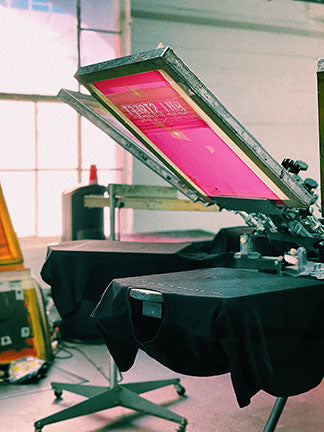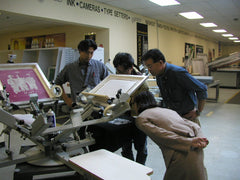
When beginners start to screen print they make a lot of mistakes during the process. Prints wash out. Bleeding. Even spot flash drying can be an on-press problem. Don’t worry. These problems are easy to fix. We’ve compiled a list of the most common problems beginning screen printers who use plastisol inks deal with. These screen printing solutions will help you create better screen prints.
Problem: Washed away prints. The image is washing away because your ink has not totally cured.
Solution: There are a few ways to fix this. The first one is simple. Dry your screen prints longer. Leave them in the conveyor heat chamber longer. Secondly, make sure your conveyor dryer is reaching the proper temperature. If it isn’t the ink won’t dry. Third, check the manufacturer’s recommendations. Make sure the belt speed and oven temp match what the manufacturer recommends. Many inks cure at 320 degrees. This can be a problem. You can use low-cure ink. Dynamic Ink cures at 280. Stop your screen printed images from washing out.
Problem: Opaque Prints. When the ink deposit on a shirt doesn’t block out the garment color solidly. You have dull and weak prints.
Solution: Leaving a thicker ink deposit will make your print more opaque. This is done by using a screen with a lower mesh count, a thick stencil (more emulsion), or a large amount of off contact. You could also print a white underbase. To make the color look vibrant use a white underbase. Sometimes the sequence needs to be altered. Use a print - flash - print sequence and put two layers on top of each other.
Problem: Dye Migration: On polyester and certain 50/50 or tri-blend shirts the dye heats up and becomes a gas and “migrates” up from the shirt through the ink. This happens when the temperature reaches 300 degrees.
Solution: Stop using plastisol and use a low-cure ink. The ink will dry around 280 degrees. With a traditional ink you will constantly have a problem with migration. You can reduce the conveyor temperature with a low-cure ink.
Problem: Screen Print Peeling: Once a print is dried the edges of the plastisol ink peel.
Solution: The plastisol ink that you are using has not cured, or the ink isn’t right for the type of shirt. There are inks that are only meant to be printed on cotton, or polyester. If you use the inks differently it will cause problems. The ink must work with the garment. Read the manufacturer’s label for instructions and recommendations. You should check that the ink has properly cured as well. It could be as simple as not curing long enough.
Problem: When the color you are printing won’t stick to the underbase. Remember a white underbase will make your colors look fantastic, but if it is not working properly then you have problems.
Solution: The underbase is overflashed. You only need to flash your underbase. You do not need to fully cure it. The color will not adhere if it is fully cured. Sometimes you will over flash. Try spot curing for a short time or raise your flash unit higher. You could also turn down the spot dryer. Flashed ink should feel tacky and wet.
Problem: Fibrillated prints. Cotton fibers are sticking up through your images. Your print will look fuzzy and faded.
Solution: Use a thicker ink layer. Fibers can be matted down with more ink. If that doesn’t work you can try a higher ink quality. Cheap plastisol ink has “filler” components. These “filler” components aren’t as dense as quality components. Cheap plastisol can lead to worse fibrillation. You can also try adding an underbase. This will add more ink that acts like a barrier to keep fibers from getting into your final image.
Problem: Stiff Prints. This isn’t really a problem. It’s a preference. A heavier feel is perfect for some people. You can make it feel lighter.
Solution: A soft hand extender will help lighten up your plastisol ink. Follow the manufacturer's instructions or your color vibrancy will suffer. Your final print will feel softer.
Problem: Ghost Images. When the printed image shows through to the other side of the shirt you have a ghost image.
Solution: Cheap ink is likely the cause of a ghost image. Cheap inks commonly have bleaching agents in them. If you use a higher quality of ink then you won’t have this problem. A high quality ink like Dynamic Ink is not made with a lot of “fillers”. It is also phthalate free.
Problem: Cracking Prints. Nobody likes cracked prints. This usually happens when a shirt is washed for the first time. It is usually caused by uncured ink.
Solution: Using your thumbs, test your prints by stretching them. Not too much. Just slightly. The ink won’t crack if properly cured. If it does crack then you need to cure the shirts longer.
Problem: Shirts Sticking Together. This is a huge problem. It could ruin your screen print. It occurs when you have not given the ink enough time to cool down. After it is dried, it needs to cool down.
Solution: Before folding or packing you need to give them some time. You can also try using a fan to speed up the process
Wrapup
These are just some of the most common screen printing problems. It’s a process of trial and error. No two shirts are alike so you may have to experiment. These solutions will help you become a stronger screen printer.




Leave a comment